Often overlooked in avian species, the Woolly-Necked Stork is a fascinating bird that deserves our attention. Found widely across tropical Asia and Africa, it’s known for its distinctive woolly white neck from which it derives its name.
This mid-sized stork displays an intriguing physical appearance and unique behaviors that set it apart from its feathered peers.
The Woolly-Necked Stork boasts a black body with a contrasting white neck, giving it an air of elegance and sophistication. They’re primarily terrestrial water birds adapted to live on land and in wetland environments.
From feeding habits to nesting patterns, this species exhibits diverse survival strategies – making them captivating subjects for ornithologists and bird enthusiasts.
Despite their wide distribution range, these storks face several threats leading to population decline in certain regions.
Raising awareness about conservation efforts to protect the Woolly-Necked Stork is crucial, ensuring these charismatic creatures continue gracing our skies for generations.
Physical Characteristics of the Woolly-Necked Stork: A Fascinating Avian Study
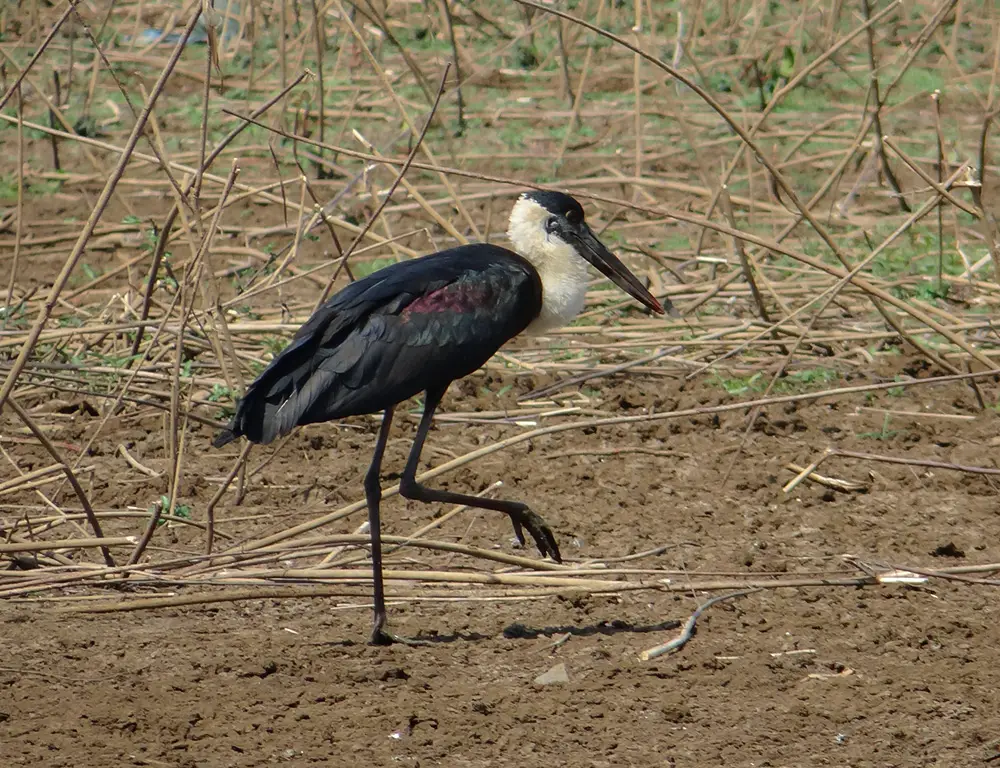
The Woolly-Necked Stork (Ciconia episcopus) possesses several distinctive physical characteristics that make it a visually striking bird. Here’s a detailed overview:
Size
On average, Woolly-Necked Storks stand at a height ranging from 75 to 92 centimeters (approximately 30 to 36 inches). This places them in the category of medium-sized storks.
Weight
There’s a notable difference in weight between males and females. Males typically weigh between 2.3 and 2.9 kilograms, while females are lighter, weighing around 1.8 to 2.4 kilograms.
Coloration
The body of the Woolly-Necked Stork is predominantly black, with glossy feathers covering most of its frame. However, its most distinctive feature is its woolly white neck, which contrasts sharply with the black plumage and gives the bird its name.
The white plumage is particularly dense and fluffy, especially around the neck.
Legs
These storks have long, slender legs, typically colored in black or dark grey. These legs are adapted for wading through water, allowing the stork to navigate its wetland habitats easily.
Beak
Like many stork species, the Woolly-Necked Stork has a long, pointed beak, which it uses for capturing prey. The beak is typically a shade of yellow or orange, adding a splash of color to the bird’s appearance.
Wings
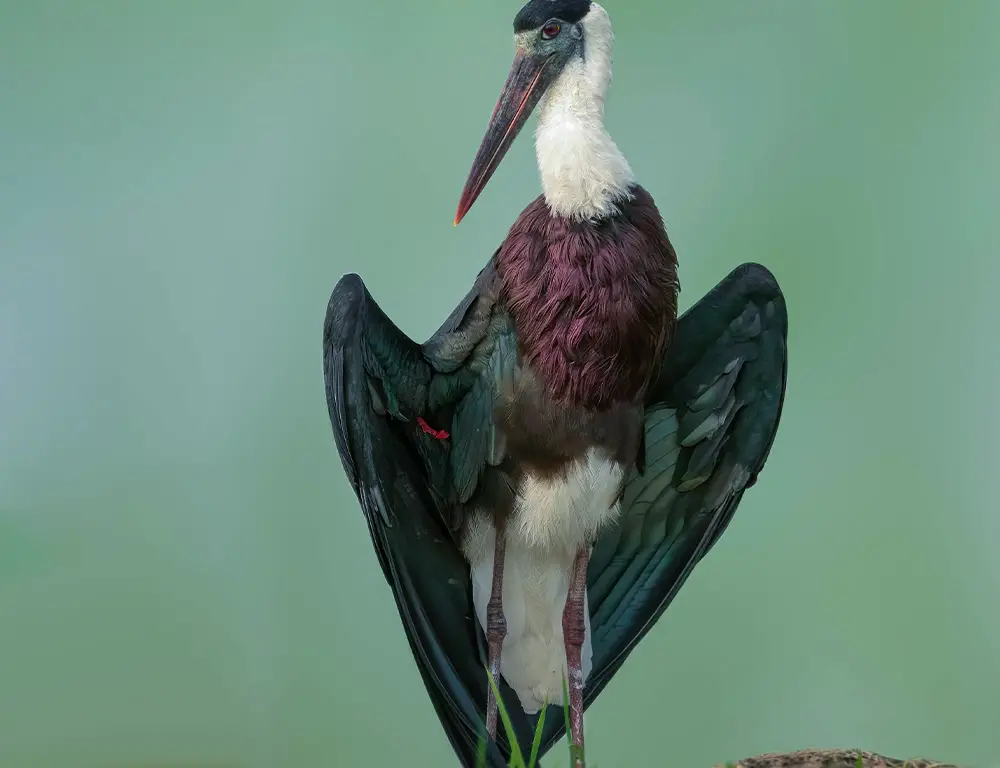
Woolly-necked storks have large wings with an impressive wingspan reaching up to 150 centimeters (approximately 59 inches). These wings are essential for flight, allowing the stork to cover long distances during migration and foraging.
Plumage
Apart from the white neck feathers, the Woolly-Necked Stork’s plumage exhibits iridescence, especially in sunlight.
This luminescence can display streaks of green and purple amidst the predominant black hue, adding to the bird’s visual appeal.
Sexual Dimorphism
In addition to the weight difference mentioned earlier, male and female Woolly-Necked Storks may have subtle differences in size and plumage coloration. However, these differences are only sometimes easily discernible.
Habitat and Distribution of the Woolly-Necked Stork: Exploring Its Range and Adaptability
The Woolly-Necked Stork (Ciconia episcopus) is a highly adaptable bird species in tropical Asia and Africa. Here’s a detailed overview of its habitat and distribution:
Habitat
- Wetlands: Woolly-necked storks are often found in wetland habitats such as marshes, swamps, and riverbanks. These environments provide abundant food sources like fish, frogs, and insects, making them ideal foraging grounds.
- Grasslands: They also inhabit grassland areas, where they may nest and forage in open fields and meadows. Grasslands offer opportunities to hunt for small mammals and reptiles.
- Agricultural Fields: In some regions, Woolly-Necked Storks have adapted to agricultural landscapes, where they may feed on pests like insects and rodents, providing a natural form of pest control.
- Forests: While not strictly forest dwellers, these storks may venture into forested areas, especially during breeding season, to build nests in tall trees.
Distribution
- Asia: In Asia, Woolly-Necked Storks are distributed across various countries, including India, Nepal, Sri Lanka, Bangladesh, Myanmar, Thailand, and Indonesia. They are ubiquitous in South Asia, where wetlands are abundant, especially during the monsoon season.
- Africa: Across Africa, these storks can be found in Sub-Saharan regions, including South Africa, Zimbabwe, Botswana, Zambia, Kenya, Tanzania, and Uganda. They inhabit wetland areas, savannas, and grasslands throughout their range.
- Specific Locations: Within their range, Woolly-Necked Storks may be found in particular locations such as Ranthambore National Park in India, Chitwan National Park in Nepal, and various protected areas and wetland reserves across Africa.
Altitude and Climate
Woolly-necked storks demonstrate remarkable adaptability to different altitudes and climates. They can be found at sea level in coastal areas and at higher altitudes, reaching up to around 2400 meters (approximately 7874 feet) above sea level.
This adaptability allows them to thrive in various environmental conditions, from humid tropical regions to semi-arid savannas.
Behavior and Diet of the Woolly-Necked Stork: Insights Into This Fascinating Avian Species
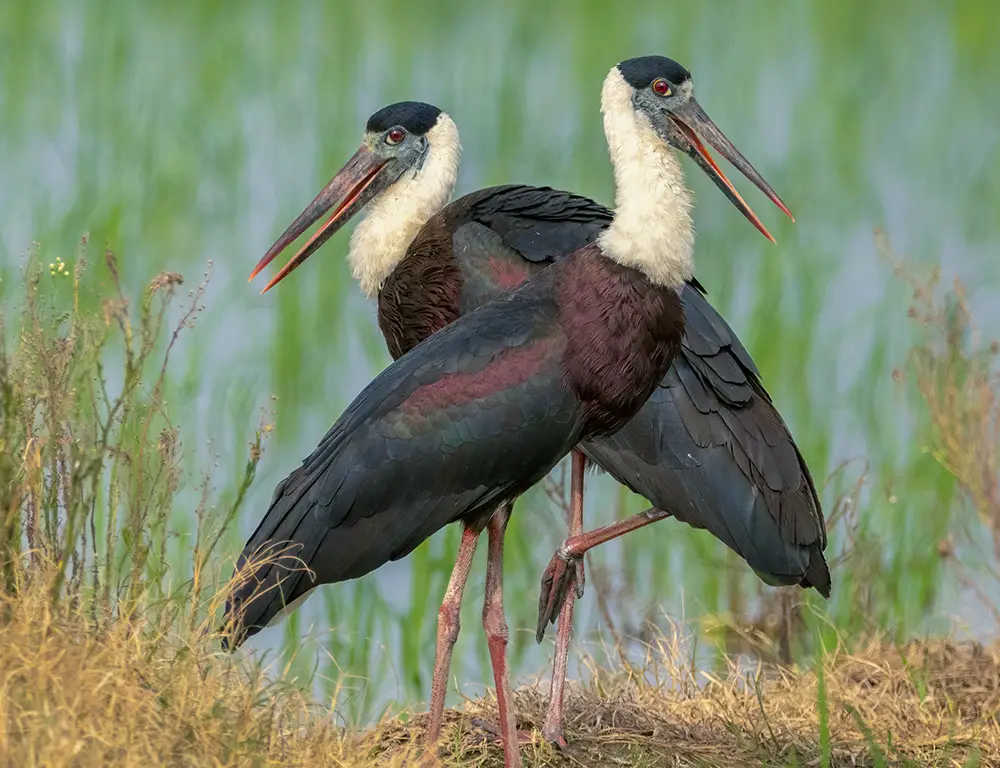
The Woolly-Necked Stork (Ciconia episcopus) exhibits fascinating behaviors and dietary habits contributing to its survival and ecological role. Here’s an overview of its behavior and diet:
Breeding Behavior
Intricate rituals and cooperative efforts between mating pairs characterize the breeding behavior of the Woolly-Necked Stork. Here’s a detailed overview:
Pair Bonding
Woolly-necked storks engage in pair bonding, forming monogamous relationships during the breeding season. Mates often engage in courtship displays, including bill-clattering, bowing, and other ritualistic behaviors to reinforce their bond.
Nesting
Breeding pairs construct large nests of sticks, twigs, and other plant materials. These nests are typically built high in trees or cliff edges to protect them from predators. Both male and female storks participate in nest construction.
Egg Incubation
Once the nest is constructed, both parents take turns incubating the eggs, which usually number between 2 and 5 per clutch. Incubation lasts for approximately 30 days.
Parental Care
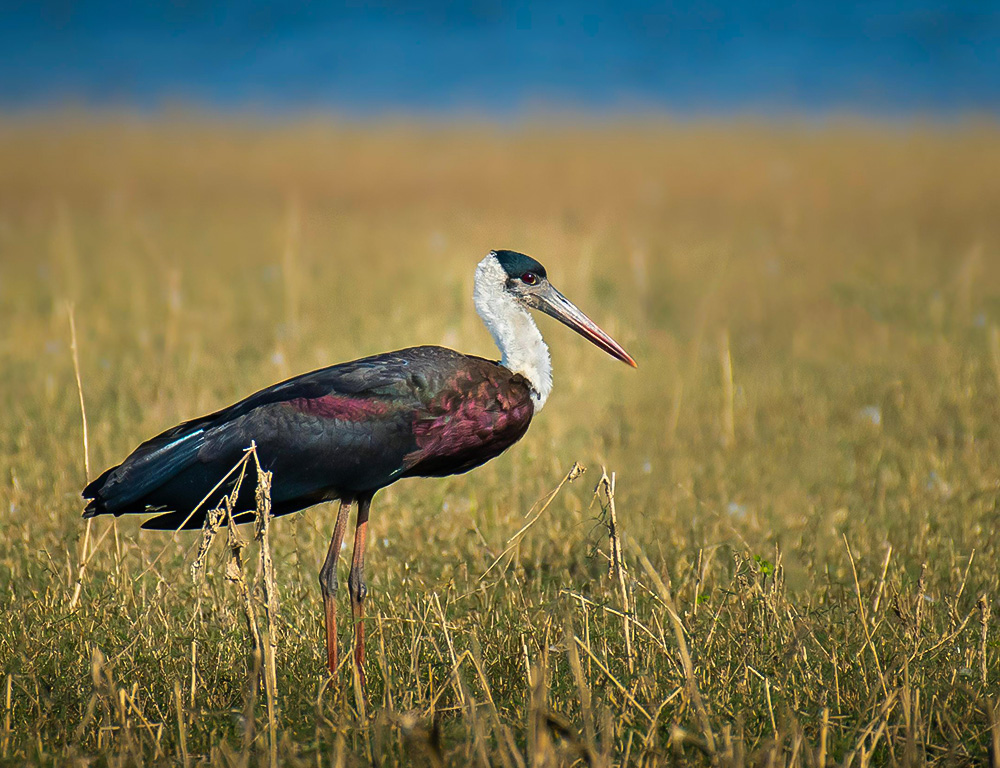
After hatching, both parents care for the chicks, providing them with food and protection. Chicks remain in the nest for about six weeks before fledging.
Feeding Habits
The Woolly-Necked Stork (Ciconia episcopus) is an opportunistic feeder with a diverse diet that reflects its adaptability to various habitats. Here’s a detailed overview of its feeding habits:
Opportunistic Feeding
Woolly-necked storks are opportunistic feeders, preying on various small animals depending on availability. Their diet primarily consists of:
- Frogs: Approximately 40% of their diet consists of frogs, which they catch in shallow water.
- Fish: Fish make up around 30% of their diet. Storks hunt for fish in freshwater streams, ponds, and wetlands, using their sharp beaks to catch them.
- Insects: Insects, including grasshoppers, beetles, and dragonflies, account for about 20% of their diet, particularly during the breeding season when insects are abundant.
- Reptiles: Small reptiles such as lizards and snakes make up approximately 10% of their diet.
Hunting Strategy
Woolly-necked storks employ a patient stalking strategy when hunting for prey in shallow water. Their long legs and sharp beaks are well-adapted for capturing slippery or quick-moving creatures.
Scavenging
While primarily carnivorous, Woolly-Necked Storks are known to scavenge occasionally, taking advantage of easy meals when available.
Group Behavior
While Woolly-Necked Storks are predominantly solitary outside of the breeding season, they may form significant groups or colonies during breeding periods, especially in nesting areas.
These colonies provide opportunities for social interactions and cooperative behaviors among individuals.
Understanding the Conservation Status of the Woolly-Necked Stork: Challenges and Solutions
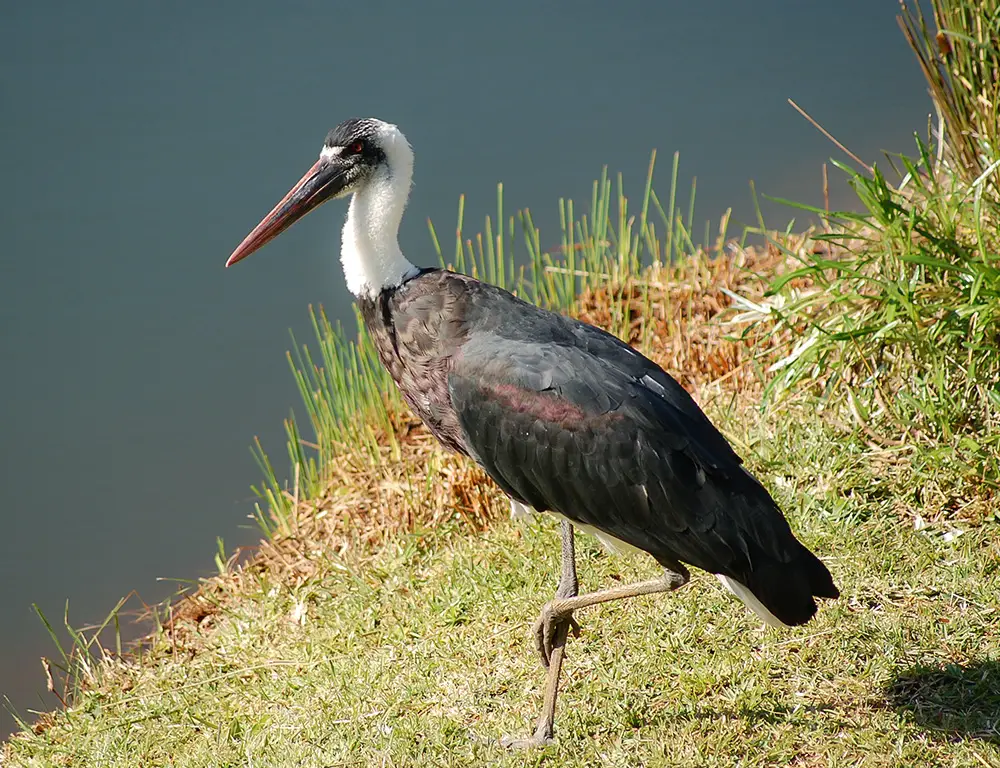
The conservation status of the Woolly-Necked Stork (Ciconia episcopus) is of concern due to the various threats it faces across its range. Here’s an overview of its conservation status:
IUCN Red List Status
The Woolly-Necked Stork is listed as “Least Concern” on the International Union for Conservation of Nature (IUCN) Red List. This classification suggests that the species does not currently meet the criteria for being classified as threatened or endangered globally.
Population Trend
Despite its “Least Concern” status, there are indications that populations of Woolly-Necked Storks are declining in certain regions. Data from surveys and observations suggest a downward population trend, particularly in areas where habitat loss and degradation are prevalent.
Regional Threats
While the species may be considered relatively stable, it faces significant threats in specific regions. For example:
- In South Asia, including India and Nepal, the Woolly-Necked Stork is considered “Near Threatened” due to habitat loss, hunting, and other anthropogenic pressures.
- Rapid urbanization, agricultural expansion, and habitat destruction are significant threats to stork populations, particularly in areas where wetlands are being drained or converted for human development.
- Pollution of water bodies, including contamination from agricultural runoff and industrial waste, can also negatively impact stork habitats and prey availability.
Conservation Efforts
Despite these challenges, efforts are underway to protect and conserve the Woolly-Necked Stork and its habitats. Conservation measures include:
- Legal Protection: The species is legally protected from hunting in several countries where it occurs, including Thailand and South Africa. These regulations help mitigate direct threats to stork populations.
- Protected Areas: National parks and wildlife reserves across the species’ range provide sanctuary for storks and other wildlife. Examples include Ranthambore National Park in India and Chitwan National Park in Nepal, where storks are afforded protection within designated conservation areas.
- Habitat Restoration: Conservation organizations and governmental agencies work to restore and preserve wetland habitats critical to stork survival. Wetland restoration efforts aim to maintain healthy ecosystems and ensure the availability of food and nesting sites for storks.
Conclusion
The Woolly-Necked Stork emerges as a captivating avian species, showcasing adaptability across diverse habitats in Asia and Africa.
Its unique features and behaviors, from solitary foraging to communal breeding, offer rich avenues for study and appreciation among ornithologists and nature enthusiasts.
While globally categorized as “Least Concern,” localized threats such as habitat loss in regions like South Asia warrant attention. Recognizing their ecological significance in pest control underscores the importance of conservation efforts.
Through continued research and conservation initiatives, we can safeguard these majestic birds and their habitats, preserving their invaluable contribution to biodiversity.
Embracing the ethos of understanding and protecting all species, the journey with the Woolly-Necked Stork reinforces the imperative of nurturing and conserving our planet’s rich natural heritage.